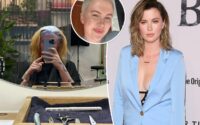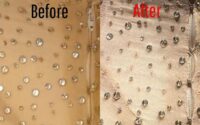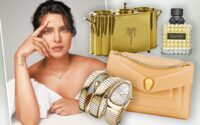Every woman needs this new roofie-detecting lip gloss tube
You can kiss danger goodbye.
An innovative lip gloss tube that can detect date rape drugs and call for help is on the market to ensure the safety of women everywhere.
Produced by Esōes Cosmetics, the $65 product — which comes in a variety of shades as well as two matte liquid lipsticks — includes testing strips and a high-tech case equipped with a button that, when pressed if connected to Bluetooth, can contact emergency services via the company’s location-enabled safety app.
“We provide a real way to detect and confirm the presence of common date rape drugs in drinks and call for help immediately before a person becomes unconscious,” Esōes, pronounced “SOS,” founder and CEO Joy Hoover told The Post in a statement, adding that the prevalence of such products will likely deter malicious actors.
“By giving people the power to test their drinks and call for help with just a push of a button, we raise awareness, encourage reporting, and ultimately, cut down on drink spiking incidents.”
And who doesn’t use a lip product? Whether it be balm, gloss or lipstick, those items are among the most commonly used products by Americans, with 81% of women and 39% of men using a lipstick or lip balm, Hoover said.
“When I would speak in huge groups of women, I would be like, ‘Who carries mace?’ And no one would raise their hands. So I was like, ‘Well, who carries lipstick?’ And everyone raised their hands,” Hoover told InStyle.
“When I was looking at the market, there are fentanyl strips, but there’s no drink strip.”
The case has a hidden compartment in the bottom of the tube that holds testing strips, which work like pregnancy tests when dipped into a beverage — two lines mean the drink is safe, while one line means roofies are present.
The benzodiazepine test strips can detect drugs such as rohypnol or “roofies,” xanax, valium, ativan, among others, according to the product listing.
The idea for the product was inspired by Hoover’s personal experiences. Just over a decade ago, her mother-in-law was killed by her father-in-law.
“It was a moment that could have halted our world, but instead, we chose to be a source of light. We channeled our grief into creating a social impact company that has since empowered over 10,000 survivors,” Hoover, who previously worked in a role to support survivors of sex trafficking and gender-based violence, told The Post.
“In 2021, we asked ourselves a crucial question: ‘What tools could have saved Marcia Hoover? What tools were available that could help prevent the abuse faced by the 10,000+ clients we’ve served?’ After a global patent search, we found that the shocking answer was nothing.”
Hoover had also been roofied before, she told InStyle, but “didn’t understand all the statistics” — or lack thereof.
Experts say it’s almost impossible to know just how prevalent drink spiking is, in part due to insufficient data and a lack of reporting. People who have been drugged may not realize, or they may not seek help at a hospital to confirm their suspicions, so estimates are likely inaccurate.
Findings from a 2016 study suggested that drink spiking might be more common than previously believed, and according to a survey of more than 900 adults from the American Addiction Centers, 56% of women and 44% of men said they have consumed food or drinks that were spiked at least once in their lifetime.
“Women often gaslight themselves into thinking they just drank too much or that it’s their fault, all due to a culture of victim-blaming,” Hoover told The Post. “This self-doubt and internalized blame lead to underreporting and a lack of solid data on how common drink spiking really is.”
Last month, Hoover was one of 20 entrepreneurs to receive the Botox Cosmetic and IFundWomen’s Grant thanks to her life-saving lip gloss.
She intends to use the $25,000 in funds to expand upon the product, which is billed as the first patented liquid lipstick or gloss to feature drink testing strips and a Bluetooth-connected panic button in its design.
Hoover told The Post she is developing GHB/Ketamine/Benzodiazepine test strips to “become the first to market with a drink testing option that detects the top 3 date rape drugs,” and will also provide the opportunity for the strips to be distributed to businesses.
Now, one year after its launch, Esōes has become the saving grace for customers, who are part of “the lipstick and safety revolution.”
“We often hear stories from customers who’ve pushed their panic button in unsafe situations and felt immense relief when their emergency contact reached out,” Hoover told The Post.
“We also receive emails like this: ‘I was wondering if you’d be restocking soon? I was drugged and raped when I was 19 (I’m 23 now), and I’ve been so anxious every time I go out, especially since it was through a water bottle. I’d love to get a lipstick from your company because maybe then I’ll have some peace of mind when I go out.’”
Even Hoover’s young daughter — who once jokingly suggested the idea for the safety lipstick — pressed the panic button when she was being bullied at school, and Hoover herself used the call button to contact the fire department when her house caught fire just this month.
“I was trying to look at violence as a whole, from my daughter’s safety at school to a trafficking survivor or someone living with their active abuser,” Hoover told InStyle. “How could we get as many of the safety features as possible?”


